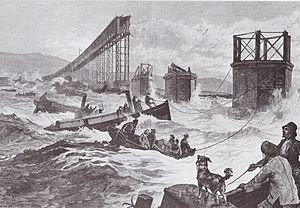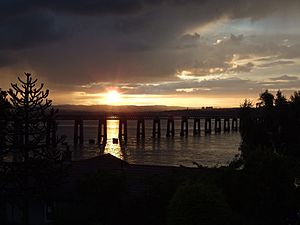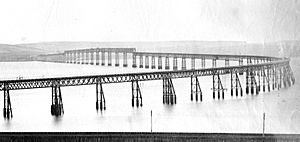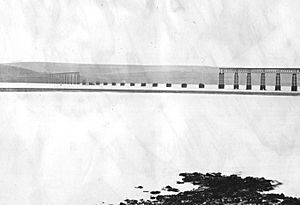Tay Bridge disaster facts for kids
The Tay Bridge disaster was a terrible accident that happened during a huge storm on December 28, 1879. The first Tay Rail Bridge collapsed while a train was crossing it from Wormit to Dundee. Everyone on board the train died. This event was one of the biggest engineering failures of the 1800s.
Contents
Building the First Rail Bridge
The Tay Bridge was designed by a famous railway engineer named Thomas Bouch. He even received a knighthood after the bridge was finished.
The bridge used a special "lattice-grid" design. This design combined two types of iron: cast iron and wrought iron. This design had been used successfully before, like in the Crumlin Viaduct in South Wales in 1858.
Another bridge, the Dee bridge, had collapsed in 1847. It failed because cast-iron girders were not used correctly. In 1867, Gustave Eiffel (who later designed the Eiffel Tower) used a similar design for large viaducts in France.
People had wanted to build a bridge across the River Tay since at least 1854. The law allowing the bridge to be built was passed on July 15, 1870. Construction officially began when the first stone was laid on July 22, 1871.
Bridge Design: The Main Idea
The first plan for the bridge involved lattice girders supported by brick pillars. These pillars were supposed to rest on solid rock, called bedrock, which engineers thought was close to the river's surface.
At both ends of the bridge, the single railway track ran on top of the bridge's main structure. But in the middle section, called the "high girders," the railway ran inside the bridge structure. This made the bridge tall enough for sailing ships to pass underneath on their way to Perth.
However, as construction moved into the river, workers discovered in December 1873 that the bedrock was much deeper than expected. It was too deep to support the bridge pillars.
So, Thomas Bouch had to change his design. He reduced the number of pillars and made the bridge sections between them longer. Instead of reaching bedrock, the pillar foundations were built by sinking large, brick-lined iron tubes, called caissons, onto the riverbed.
How the Work Was Done
The company originally hired to build the bridge went bankrupt while Bouch was redesigning it. A new company took over, but their work was not very good.
Almost every part of the bridge was below standard. This included the iron used and the way parts were connected. Bolts and braces didn't fit perfectly, so workers had to fix them on-site. One person who saw the work later described it as "about as slovenly a piece of work as ever I saw in my life."
Bridge Opening
The Tay Bridge opened for trains carrying passengers on June 1, 1878. The next year, on June 20, 1879, Queen Victoria herself crossed the bridge. She was returning south from Balmoral Castle.
Before she crossed, Bouch was introduced to her. Just six days later, on June 26, 1879, the Queen made him a knight at Windsor Castle.
The Tay Bridge Disaster
On the evening of December 28, 1879, at 7:15 PM, a terrible event occurred. The bridge collapsed when its central sections gave way during strong winter gales.
A train with six carriages, carrying 75 passengers and crew, was crossing the bridge at that exact moment. It fell into the freezing waters of the Tay River. All 75 people died. This disaster shocked the entire country and deeply affected engineers of that time.
During the collapse, a very strong wind, like a tropical storm (55–72 mph or 80–117 km/h), was blowing across the Tay estuary. The train's engine was later pulled from the river and repaired so it could be used again.
The collapse of the Tay Bridge, which had only been open for 19 months and was declared safe, is still the most famous bridge disaster in the British Isles. Even today, you can still see the stumps of the original bridge pillars sticking out of the Tay River, even at high tide.
Official Inquiry Report
What Caused It
An official investigation looked into the disaster. The inquiry concluded that "the fall of the bridge was caused by the cross-bracings and fastenings not being strong enough to withstand the force of the gale on the night of December 28th 1879." They also noted that the bridge had already been weakened by earlier storms.
However, the report also said that the bridge, if built perfectly as designed, might not have failed just from the wind. An engineer who studied the design in detail explained:
"If the bridge had been built perfectly, a wind pressure of 37 pounds per square foot would have knocked it down. But it didn't fall in the way a perfect structure would have. The way it fell shows there must have been weak points in the structure." He added that knowing about parts that already needed repairs showed him "that the structure was not in that perfect condition."
The middle section of the bridge, where the train ran inside the tall girders, was likely top-heavy. This made it very weak against strong winds. Neither Thomas Bouch nor the builders seemed to have regularly checked the on-site foundry. This is where iron from the earlier, half-built bridge was recycled.
The round cast iron columns that supported the 13 longest sections of the bridge (each 245 feet or 75 meters long) were of poor quality. Many had been cast lying down, which meant their walls were not evenly thick. There was also some evidence that bad work was hidden from the inspections, which were not very thorough.
Specifically, some of the "lugs" (small parts used to attach the wrought iron bracing bars) had been "burnt on" instead of being cast as one piece with the columns. Even the normal lugs were very weak. Tests for the inquiry showed they broke at only about 20 long tons, much less than the expected 60 long tons. These weak lugs failed and made the entire middle of the bridge collapse during the storm.
Simply put, the bridge failed because of problems in how it was made. This meant it could not stand up to the strong winds, even though the designer had planned for it to be much stronger.
- Report of the Court of Inquiry and report of Mr Rothery. Stationery Office, London 1880. [1]
- Tay Bridge Disaster: Appendix to the Report Of The Court of Inquiry. [2]
Images for kids
See also
 In Spanish: Desastre del puente del Tay para niños
In Spanish: Desastre del puente del Tay para niños













